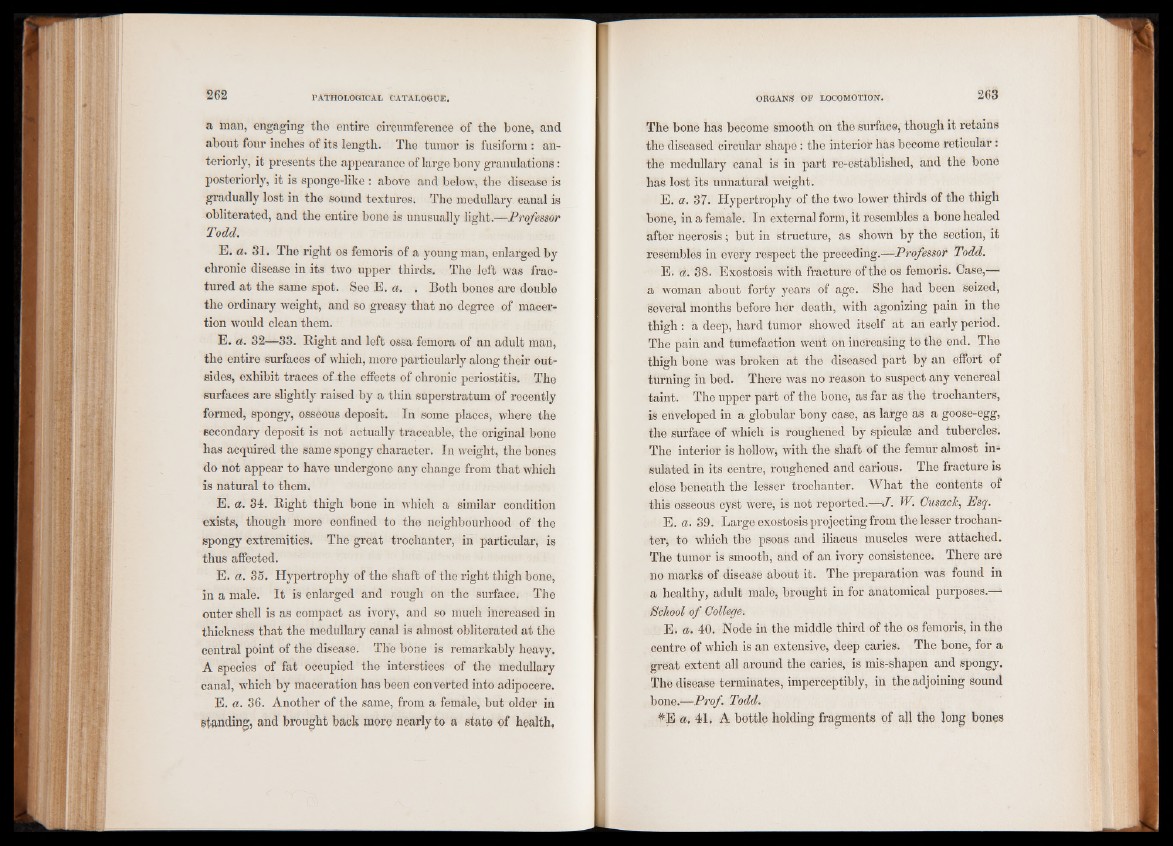
a man, engaging the entire circumference of the bone, and
about four inches of its length. The tumor is fusiform : anteriorly,
it presents the appearance of large bony granulations:
posteriorly, it is sponge-like : above and below, the disease is
gradually lost in the sound textures. The medullary canal is
obliterated, and the entire bone is unusually light.—Professor
Todd.
E. a. 31. The right os femoris of a young man, enlarged by
chronic disease in its two upper thirds. The left was fractured
at the same spot. See E. a. . Both bones are double
the ordinary weight, and so greasy that no degree of macer-
tion would clean them.
E. a. 32—33. Right and left ossa femora of an adult man,
the entire surfaces of which, more particularly along their outsides,
exhibit traces of the effects of chronic periostitis. The
surfaces are slightly raised by a thin superstratum of recently
formed, spongy, osseous deposit. In some places, where the
secondary deposit is not actually traceable, the original bone
has acquired the same spongy character. In weight, the bones
do not appear to have undergone any change from that which
is natural to them.
E. a. 34. Right thigh bone in which a similar condition
exists, though more confined to the neighbourhood of the
spongy extremities. The great trochanter, in particular, is
thus affected.
E. a. 35. Hypertrophy of the shaft of the right thigh bone,
in a male. It is enlarged and rough on the surface. The
outer shell is as compact as ivory, and so much increased in
thickness that the medullary canal is almost obliterated at the
central point of the disease. The bone is remarkably heavy.
A species of fat occupied the interstices of the medullary
canal, which by maceration has been converted into adipocere.
E. a. 36. Another of the same, from a female, but older in
standing, and brought back more nearly to a state of health,
The bone has become smooth on the surface, though it retains
the diseased circular shape: the interior has become reticular:
the medullary canal is in part re-established, and the bone
has lost its unnatural weight.
E. a. 37. Hypertrophy of the two lower thirds of the thigh
bone, in a female. In external form, it resembles a bone healed
after necrosis; but in structure, as shown by the section, it
resembles in every respect the preceding.— Professor Todd.
E. d. 38. Exostosis with fracture of the os femoris. Case,—
a woman about forty years of age. She had been seized,
several months before hér death, with agonizing pain in the
thigh : a deep, hard tumor showed itself at an early period.
The pain and tumefaction went on increasing to the end. The
thigh bone was broken at the diseased part by an effort of
turning in bed. There was no reason to suspect any venereal
taint. The upper part of the bone, as far as the trochanters,
is enveloped in a globular bony case, as large as a goose-egg,
the surface of which is roughened by spiculse and tubercles.
The interior is hollow, with the shaft of the femur almost insulated
in its centre, roughened and carious. The fracture is
close beneath the lesser trochanter. What the contents of
this osseous cyst were, is not reported.—J. W. Cusack, Esq.
E. a. 39. Large exostosis projecting from the lesser trochanter,
to which the psoas and iliacus muscles were attached.
The tumor is smooth, and of an ivory consistence. There are
no marks of disease about it. The preparation was found in
a healthy, adult male, brought in for anatomical purposes.—•
School of Colleges.
E. a. 40. Node in the middle third of the os femoris, in the
centre of which is an extensive, deep caries. The bone, for a
great extent all around the caries, is mis-shapen and spongy.
The disease terminates, imperceptibly, in the adjoining sound
bone.—Prof. Todd.
f-E a, 41, A bottle holding fragments of all the long bones